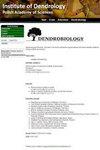利用FISH核型分析揭示了白杨、山杨及其杂交种染色体结构的相似性
IF 1.8
4区 农林科学
Q2 FORESTRY
引用次数: 0
摘要
杨树属是朝鲜半岛和世界上许多国家的重要树种之一。它代表了森林基因组学的模式物种,因为它生长快,繁殖快。因此,人们对它们的遗传特征进行了很好的研究,并对一些物种的全基因组进行了测序。然而,对杨树属植物的细胞遗传学研究还很有限。本研究采用荧光原位杂交(FISH)技术对韩国白杨(P. tremula var. davidiana)、银杨(P. alba)及其两个杂交品种水原白杨(P. tremula var. glandulsa)和Hyun杨杨(P. alba × P. tremula var. glandulsa)的核型进行了分析。根样本是从位于韩国京畿道水原的示范森林的成熟树木上采集的。采用DAPI(4′,6-二氨基-2-苯基吲哚)染色,45S rDNA和5S rDNA探针检测新鲜根细胞。结果表明,各种属的染色体组成均为2n = 38。韩杨、银杨、水原杨和玄杨的核型公式分别为28m + 6sm + 4st (2sat)、26m + 10sm (2sat) + 2st、26m + 12sm (2sat)和28m + 10sm (2sat)。这4个物种与FISH核型共有1对45S rDNA位点和1对5S rDNA位点。四种间FISH核型的相似性表明它们的种间杂交亲缘关系密切,且存在共存关系。本研究将为杨树的细胞遗传学研究和遗传作图提供遗传信息,为杨树的育种规划提供参考。本文章由计算机程序翻译,如有差异,请以英文原文为准。
Similarity of chromosome structure among Populus tremula var. davidiana, Populus alba and their hybrids revealed by FISH karyotype analysis
The genus Populus is one of the important tree species in Korean peninsula and many other countries in the world. It represents the model species of forest genomics because it grows fast and reproduces rapidly. In this reason, their genetic characteristics have been well studied and the whole genome has been sequenced completely in some species. However, cytogenetic study of the genus Populus has been limited. In the present study, karyotypes of Korean aspen (P. tremula var. davidiana), Silver poplar (P. alba) and their two hybrids, Suwon aspen (P. tremula var. glandulosa) and Hyun aspen (P. alba × P. tremula var. glandulsa) were analyzed by means of the fluorescence in situ hybridization (FISH). Root samples were collected from mature trees in the demonstration forest, located at Suwon, Kyonggi province in South Korea. The fresh root cells were examined by DAPI (4’,6-diamidino-2-phenylindole) staining and FISH using 45S rDNA and 5S rDNA probes. As the results, the chromosome compositions of all species were the same as 2n = 38. The karyotype formulas of Korean aspen, Silver poplar, Suwon aspen and Hyun aspen were 28m + 6sm + 4st (2sat), 26m + 10sm (2sat) + 2st, 26m + 12sm (2sat) and 28m + 10sm (2sat), respectively. The four species had one pair of 45S rDNA site and one pair of 5S rDNA site in common with FISH karyotypes. The similarity of FISH karyotypes among four species indicated close genetic relationship and coexistence of their interspecific hybrids. This research will provide genetic information on cytogenetic research of Populus and genetic mapping that can be applied to the breeding program of Populus in the near future.
求助全文
通过发布文献求助,成功后即可免费获取论文全文。
去求助
来源期刊

Dendrobiology
农林科学-林学
CiteScore
2.20
自引率
11.10%
发文量
17
审稿时长
>12 weeks
期刊介绍:
Dendrobiology publishes original research articles and review articles related to the biology of trees and shrubs.
 求助内容:
求助内容: 应助结果提醒方式:
应助结果提醒方式:


